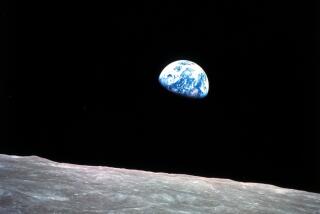In ‘Earth + Space,’ NASA photo archives reveal the universe’s vast beauty
- Share via
They are glorious works of art — turbulent abstractions as well as enchanting portraits of faraway worlds that are the stuff of sci-fi movies. Except they aren’t. These images are from “Earth + Space: Photographs From the Archives of NASA,” a Chronicle Books release due next week with text by Nirmala Nataraj.
As Bill Nye, the Science Guy, points out in the opening pages, the artists here are the engineers and scientists who launched the Hubble Space Telescope, generations of spaceships and, yes, humans who can click a camera. (Nataraj notes that the first American in space orbit, John Glenn in 1962, brought along a drugstore Ansco camera.)
Across 176 pages we see the picture that Japanese astronaut Koichi Wakata tweeted last year: Earth’s crescent moon, glowing through a prism of blue, yellow, orange and red — different wavelengths of light gathering in our atmosphere. We see the New Horizons spacecraft’s 2007 picture of the moon Io, superimposed over an infrared composite image of Jupiter, where an enduring high-pressure storm — the Great Red Spot — is rendered in a cool blue. Images from Voyager 1 in 1979 allow us to see the same planet’s swirling clouds, moving at 400 mph.
SIGN UP for the free Essential Arts & Culture newsletter >>
No Mars rover photos, but the book does run to 2014, ending with the 67P/Churyumov-Gerasimenko, the first comet to be landed on by a spacecraft (Rosetta, launched in 2004).
With technology that can reach places and see phenomena that are otherwise invisible to the human eye, Nataraj writes, “we will continue to change the way we view our Earth, our universe, and our reality.”
More to Read
The biggest entertainment stories
Get our big stories about Hollywood, film, television, music, arts, culture and more right in your inbox as soon as they publish.
You may occasionally receive promotional content from the Los Angeles Times.











